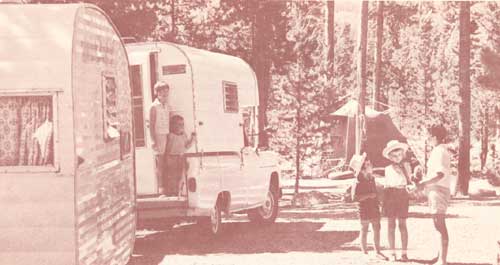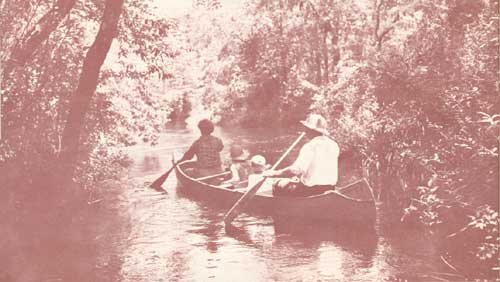|
CAMPING PA-502 |

|
CAMPING—IT'S AN AMERICAN TRADITION
The use of forests for many purposes is traditional with a people for whom the outdoors has always been close at hand. Our forefathers hunted and fished forest lands and used forest trees for building. Often in their travels, though more from necessity than for fun, they camped deep in the woods.
In later years, but still long before the establishment of the National Forests, Americans were finding relaxation and challenge in camping, fishing, hunting, and otherwise exploring the Nation's back country. Near Salt Lake City, Utah, on July 24, 1856, the President of the Mormon Church, Brigham Young, held a "Pic-nic Party" in Big Cottonwood Canyon in what is now the Wasatch National Forest. Some 450 people traveled most of the previous day and camped overnight in the canyon so as to be on time for the party.

In the 1880's the Appalachian Mountain Club was laying out trails and camping all over New Hampshire's White Mountains and their rugged Presidential Range, now the White Mountain National Forest.
In California, fishermen were the first to climb Mount Whitney (14,496 feet), highest point in the United States except for Alaska, and now a towering landmark of the Inyo National Forest. The famous golden trout is native to the Inyo and much of the High Sierra mountain country.
The renowned California naturalist John Muir camped in the 1890's throughout the Sierra, most of which is now in National Forests. The Sierra Club, devoted to outdoor travel and conservation of wild lands, was organized in Muir's time and still follows his pioneering footsteps.

|
| Redfish Lake Outlet Campground, Sawtooth National Forest, Idaho. |
Today the woods, streams, and mountains of the National Forests attract outdoor recreationists in far greater numbers than the great western migrations. They still offer much of the best camping in the country, and by automobile they can be reached readily by most of the people.
On these public lands, the Forest Service has provided nearly 7,000 camp and picnic grounds with a capacity of over half a million visitors at one time. Although no two campgrounds are identical, you can expect certain basic things at most of them. Privacy is one, if you wish it. Campgrounds are blended into the landscape to preserve the forest atmosphere, and shrubs and trees serve to screen camping units. Each unit has a place to park, a cleared spot for a tent, a firegrate, and table and benches. Several units may share trash cans, drinking water, and latrine. Some campgrounds have service connections which will accommodate the popular mobile self-contained camper units. Not all sites for trailer camping have both a table and fireplace. Some campgrounds in the back country are rather primitive and may not have tables.
In many National Forests, picnic areas are located near or adjacent to campgrounds. Picnic units contain a table, benches, and firegrate. Parking, water, and latrines are centrally located. Some picnic areas also have family camping units or community shelters.
Forest campgrounds grow more popular each year with experienced as well as amateur campers. To all visitors the Forest Service says, "Welcome to the National Forests—yours to enjoy, protect, keep clean!" This is the Forest Service's way of asking the cooperation of the one visitor in a thousand who might misuse or damage tables, signs, or other structures. Dollars saved by lowering repair and replacement costs can be used to build new recreation areas and to improve others to accommodate the increasing numbers of Americans using the forests.
If you've never camped, join those thousands who this year will camp in the woods for the first time. Get the advice of an experienced woodsman, or study camping magazines and books. Then plan a simple trip—don't be too ambitious your first time out—and head for the woods. Campers are friendly and are glad to share their woods lore. You'll learn a lot, and before your trip ends you'll be writing home, "Having a wonderful time!"

|
| Juniper Creek, Juniper Springs Recreation Area, Ocala National Forest, Florida. |
| <<< Previous | <<< Contents>>> | Next >>> |
|
PA-502/sec3.htm Last Updated: 12-Sep-2011 |